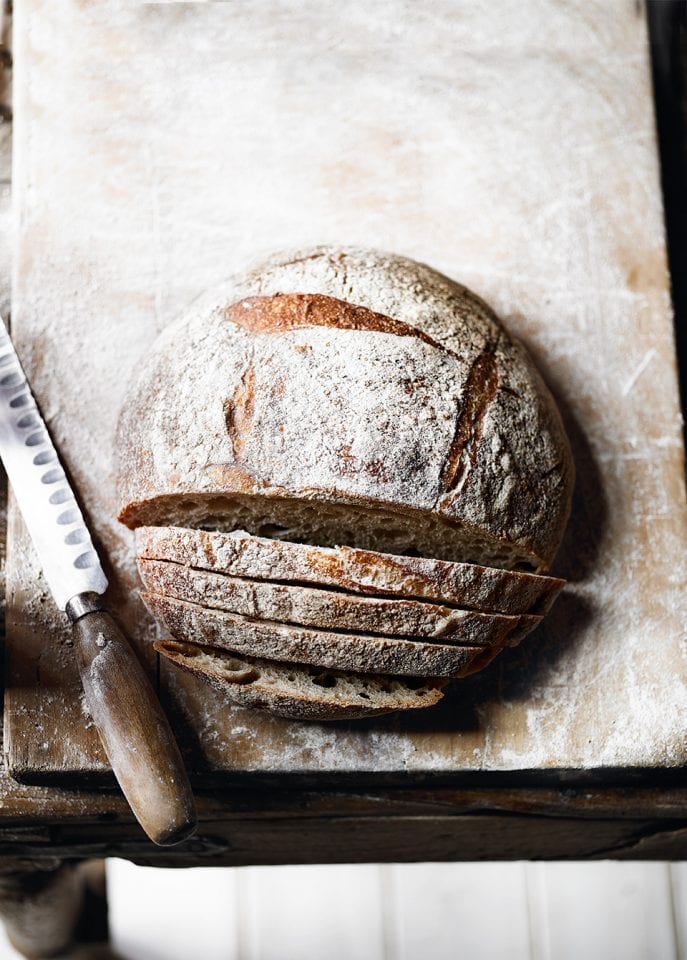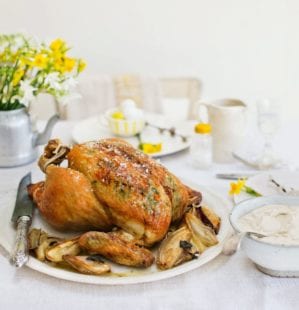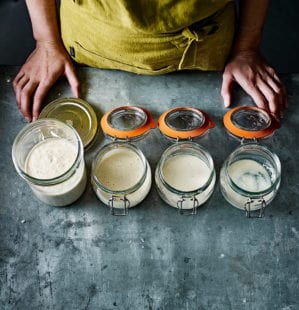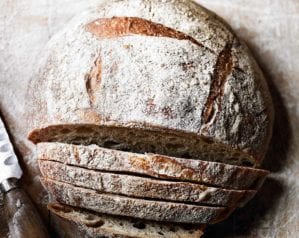
Sourdough bread
- Published: 28 Feb 14
- Updated: 18 Mar 24
Baking your own homemade sourdough bread to serve as a side dish, or on its own, is hugely satisfying. Lucas Hollweg’s recipe shows you how.

Or discover our entire guide to making sourdough at home, with tips on how to perfect your starter.
-
Serves 8-10
-
Takes 2 days to make, 30-40 minutes to cook, plus the starter
Ingredients
For the pre-ferment:
- 60g strong white bread flour
- 5g rye flour
- 30g lukewarm water
- 25g starter (See our guide)
For the loaf
- 120g pre-ferment
- 220g tepid water, plus 10g extra
- 275g strong white bread flour
- 25g rye flour, plus extra to dust
- 8g fine salt (about 1 tbsp)
- Sunflower oil to grease the bowl
Method
- Mix the pre-ferment ingredients to a stiff dough in a small bowl. Cover and leave at room temperature (about 18°C) for 12 hours to puff up.
- Break up the pre-ferment into small bits, then put in a large mixing bowl. Add the 220g water and mix until the pre-ferment has dissolved. (You can use a stick blender to make sure it is totally smooth.) Stir in the flours until no dry bits remain in the bowl. (The dough will still be a bit shaggy.) Cover and leave for 30 minutes.
- Sprinkle in the salt and the extra 5ml water and squidge both into the dough with your hands until well combined. Leave to rest for 5 minutes.
- Give the dough a set of 10-second kneads inside the bowl, folding the dough over on itself firmly 10 times until it resists, rotating the bowl a quarter-turn between folds. Cover and leave for 10 minutes. [Repeat this step three times, including the 10 minute rest].
- Turn the dough out, smooth-side down, onto a lightly floured surface and press out gently into a long rectangle. Fold a third of the length into the middle, then fold the other third over the top (as if you were folding paper to fit in an envelope), then give it a quarter turn and repeat, brushing excess flour off as you go. Put in a clean, lightly oiled bowl, cover and leave somewhere warm (about 25C) for 45 minutes. [Repeat this step twice more, including the 45 minute rest].
- Line a mixing bowl (about 20cm across) with a clean tea towel. Dust liberally with rye flour (or you can use a proving basket).
- Place the dough smooth side-down on a lightly floured surface and press out into a square. Grab a corner, fold into the centre and press down. Then make 7 more folds from around the edge to the centre, pressing down each time, so the dough is roughly round. Turn smooth side up and leave to stand for 10 minutes. Turn smooth side down again and repeat the shaping, as above, then flip smooth side up again and circle between your hands on the worktop to form a tight round ball.
- Place the ball of dough [smooth side down] in the lined bowl. Put the bowl inside a large plastic bag with enough space that bag doesn’t touch the dough, then chill in the fridge for 8 hours or overnight.
- Next day, bring the dough to room temperature and leave to prove somewhere warm – it can be up to 30C. When ready to bake, the dough should feel pillowy and soft when prodded with a finger – this can take 1-3 hours.
- Put a heavy cast-iron casserole and its lid in the oven (choose one at least 10cm deep and with a diameter just larger than your lined bowl). Switch the temperature to 250C/230C fan /gas 9.5. Leave to heat for at least 30 minutes.
- Remove the casserole from the oven. Take off the lid and carefully invert the dough into the dish. Use a very sharp knife to slash the top of the dough quickly in a square pattern (see picture). If the blade is vertical, the cuts will open up horizontally while a shallow angle will create crusty ridges (ears).
- Replace the lid and put back in the oven. Reduce the heat to 230C/210C fan/gas 8 and bake for 20 minutes, then remove the lid and bake for 20 minutes more. Carefully remove the loaf from the dish and tap the bottom. It should sound taut and drum-like. Leave to cool on a rack.
- Recipe from June 2013 Issue
Nutrition
Per 600g loaf
- Calories
- 1,319kcals
- Fat
- 6.4g (1g saturated)
- Protein
- 35.6g
- Carbohydrates
- 277.4g (4.8g sugars)
- Fibre
- 21.6g
- Salt
- 8g
delicious. tips
Many bakers like to use a pre-ferment to make their loaves. The idea is that you use a starter, with a little extra flour and water to develop and grow before using it in your bread dough. Using a pre-ferment gives the natural yeasts a bit of a boost, and also improves the flavour of the loaf.
If doubling the recipe to make 2 loaves, remove the second loaf from the fridge about an hour after the first and reheat the casserole and lid for 30 minutes at 250C/Fan 230C/Gas 9.5 before baking the second.
Buy ingredients online
Rate & review
Rate
Reviews
Subscribe to our magazine
Food stories, skills and tested recipes, straight to your door... Enjoy 5 issues for just £5 with our special introductory offer.
Subscribe
Unleash your inner chef
Looking for inspiration? Receive the latest recipes with our newsletter





